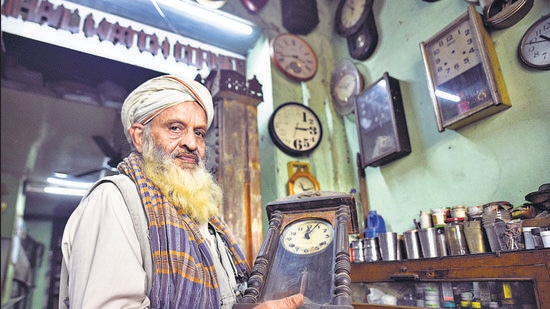For clockmakers in old Delhi, time is a friend and an enemy
Quartz and digital clocks, they say, are more accurate but they have depreciated the timepieces and their profession.
Mohammad Ayaz Khan, a clock repairer, prefers to be called a craftsman. His workshop in Churiwalan in the walled city is a charming little museum of antique clocks -- mantel, wall, table-top and, cuckoo clocks -- many of them over a hundred years old. There are others packed in cardboard boxes that have come for repair from across the country through courier. “There are a few clockmakers like me who have survived in this age of quartz clocks,” says Khan as he examines, like a biologist, the clock plate of a century-old Smiths Enfield clock.

“Its bushings have worn off. I will have to disassemble its entire mechanism and change its bushing to make it tick again. This British clock was once one of the most sought-after clocks brands all over the world,” says the affable Khan. The walls of his workshop have clocks of many top brands of yore such as Ansonia, Seth Thomas, Smith Enfield, and Seikosha.
For the uninitiated, Ansonia is an American company that started making clocks in Ansonia, Connecticut, in 1851, and later moved to Brooklyn New York; Seth Thomas is another American company that was incorporated in 1853; Smiths Enfield was among the first companies in Britain to get into mass manufacturing of domestic mechanical wall clocks in the 1930s; and Seikosha is a Japanese company formed in 1892, better known today as Seiko.
Spring-driven mechanical wall clocks, which harness the energy stored in a wound spring to keep the time, have a complex mechanism comprising a mainspring, several wheels, levers, and hammer, and a little maladjustment in any of the parts could result in inaccurate timekeeping or a jarring chime, says Khan.
“These mechanical clocks need to be wound at least once a week and serviced at least once a year in Indian weather conditions. The most common problem these clocks develop over the decades is the corrosion in the bushing that affects the wheel movement. People come to us when they fail to get their antique clocks repaired anywhere else,” says Khan, whose desk has a table lamp, range of forceps, screwdrivers, brushes, tweezers, spring winders, pliers. “I get clocks for repair from bungalows in Greater Kailash, Vasant Vihar, Sunder Nagar, and Defence Colony,” says Khan. He learnt clock repairing from his father Mohd Ilyas Khan, who started the workshop in 1972.
“My clients include top lawyers, including two former attorney generals and many industrialists, who often invite me to their houses or offices to fix their faulty mechanical clocks, some of which are over 200 years old. These wall clocks were once the preserve of the rich, the famous and the royals,” says Khan adding, “ A clockmaker is an artisan with the temperament of a scientist.”
Indeed, historically, some of the early clockmakers also invented scientific instruments. Take for example John Harrison, the British clockmaker whose marine chronometers revolutionised seafaring in the 18th century.
And how much could a repair cost? Anything between ₹300 to 10, 000, depending on how old the clock is and what the fault is, says Khan. “Sometimes it takes hours and sometimes it could take a week. And in some cases, we are unable to fix a clock. It happens when we are unable to get or fabricate a part.”
Not far from the Ayaz Khan’s workshop is Suhail Watch Company, near Jama Masjid, run by Suhail Akhtar. Akhtar, 63, is a living encyclopedia on mechanical clocks and watches and nothing seems to perk him up more than a conversation about them.
Before the industrial revolution, he tells you, clocks were handmade and bore the name of the individual clockmakers rather than the companies.“A clockmaker took care of the mechanism and then it would go to the case maker,” says Akhtar.
By the 20th century, standardized designs and parts made it possible to assemble clocks in factories, and clockmakers now specialised in the repair of clocks. “But we still need to have all the skills of those early clockmakers to do our job well,” says Akhtar.
Most of his clients, he adds, are people who want to get the clocks of their grandparents’ or great grandparents repaired to preserve their memories. “Otherwise, I do not have many clients these days. Mechanical clocks lost their popularity when Quartz watches arrived in the 1970s and became popular in India by the mid-1980s,” says Akhtar. It is 4pm and a grandfather clock in his workshop produces what sounds like a single Westminster chime.
Quartz clocks that use an electronic oscillator regulated by a quartz crystal to keep time, Akhtar says, are slightly more accurate but they have depreciated the timepieces and his profession. “In Quartz clocks, all you need to do is replace the machinery or the battery. It takes a couple of minutes,” he says.
Akhtar, a mechanical clock repairer for over 45 years, gets nostalgic as he talks about old clients that included the royals. “Many of them were zamindars and royals. A few years back, I was invited by a former royal in UP, who called me to repair the massive tower clock his family had installed in their city. But he said he was unable to pay the fee I demanded. They too, like us, have fallen on bad times.”




